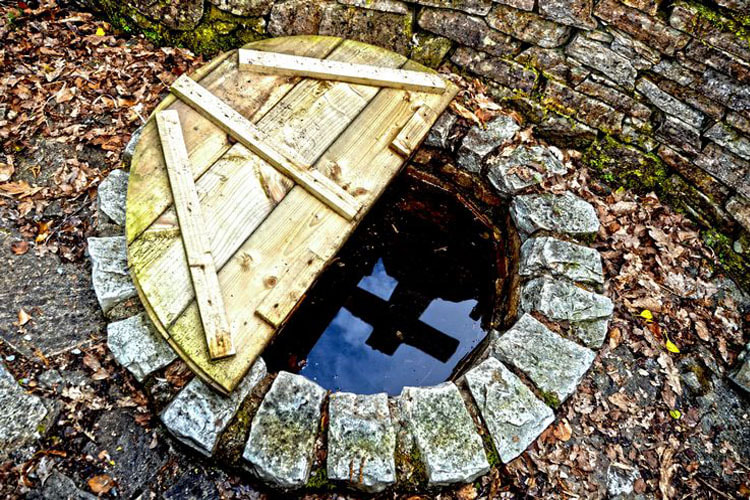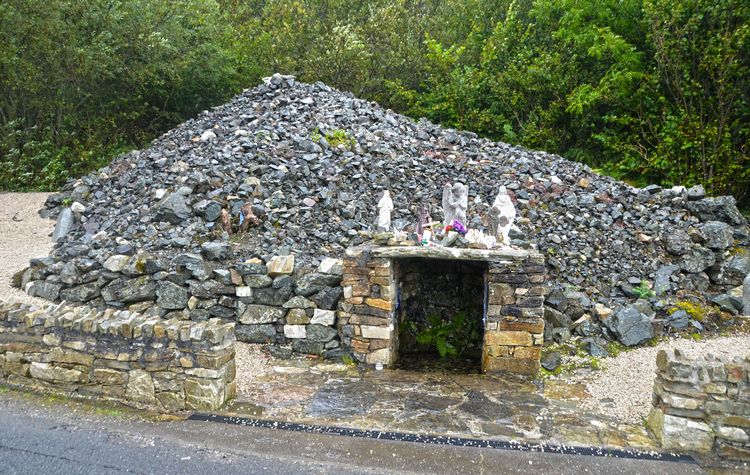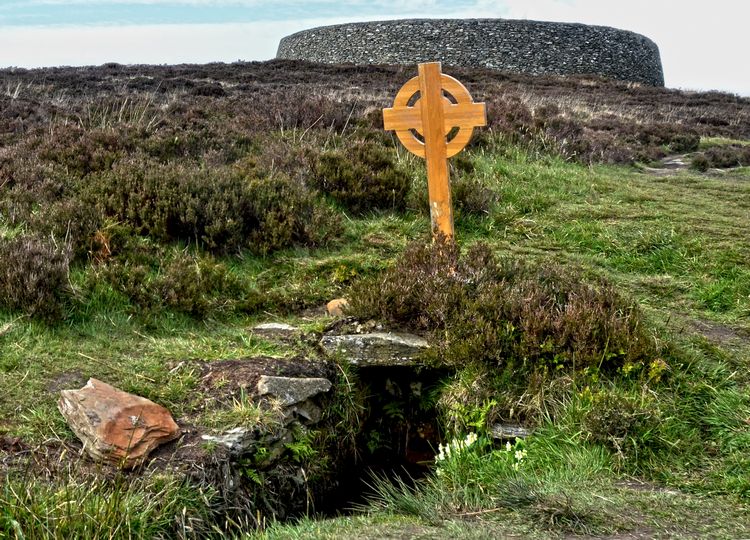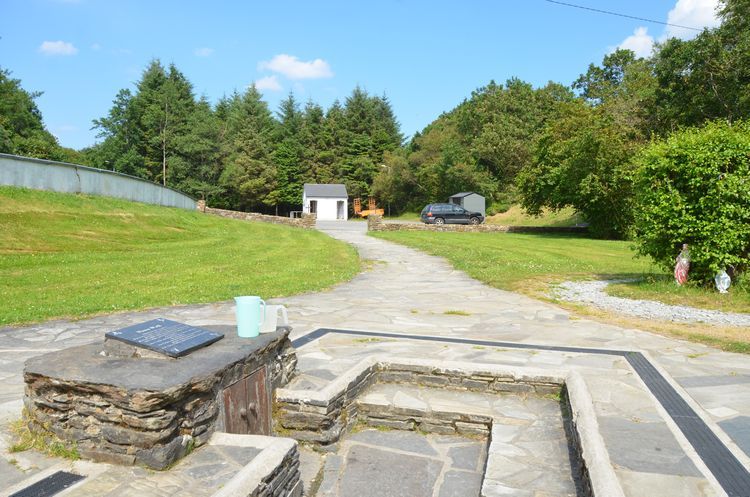HOLY WELLS OF DONEGAL
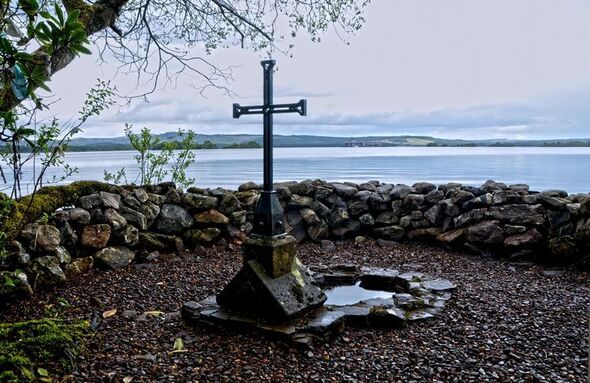 St. Bridget's Holy Well on the shores of Lough Derg, County Donegal
St. Bridget's Holy Well on the shores of Lough Derg, County Donegal
All over County Donegal there are Holy Wells dedicated to different saints and many of whose waters are thought to be curative of various ailments. Some of our Holy Wells are simply named for the cure they are attributed to have and others are much newer and usually named after a local Priest who blessed them.
Around many of the Holy Wells you will often see ‘votives’ which are things left there by the person who visited the Holy Well. They can be things like rosary beads, Holy medals, sometimes children's toys, statues of saints and so on. These belong to the person for whom the prayers are being said at the Holy Well. Often if there are bushes or trees nearby you will see bits of rag tied onto their branches and it is thought that as the rag rotted in the elements, the illness of the person being prayed for will vanish likewise. These items are called votives.
The majority of the Holy Wells of Donegal are many centuries old having their roots in paganism before Christianity came to Ireland. Once Christianised Catholics held them dear and went there to pray so often you will find nearby a Mass Rock, and too, in later years, the ruins of a Catholic church.
We are in the process of trying to visit all of the Holy Wells of Donegal to photograph them and find out more about them so we will be adding to this page from time to time with newly discovered or visited Holy Wells. You can keep up with our hunt for Holy Wells on our blog page.
PLEASE NOTE when visiting Holy Wells:
~ Never touch the votives left at these Holy Wells as they were very important to the person who left them and prayed for their loved one there.
~ Many of the Holy Wells of Donegal are on private land and you should ask locally for permission to visit those.
~ Take great care at some locations as the ground can be very rough and dangerous. Some Holy Wells are very close to the sea or loughs or rivers so care must be taken as the area could be very slippery underfoot.
~ Although local tradition may say that the water at a particular Holy Well is clear, DO NOT drink it as we cannot confirm that it is safe to do so.
And finally, if you take photographs of yourself when visiting any of Donegal's Holy Wells email them to us as we may have a section for such photos at a later stage here.
Scroll down to view some of the Holy Wells we have visited.
Around many of the Holy Wells you will often see ‘votives’ which are things left there by the person who visited the Holy Well. They can be things like rosary beads, Holy medals, sometimes children's toys, statues of saints and so on. These belong to the person for whom the prayers are being said at the Holy Well. Often if there are bushes or trees nearby you will see bits of rag tied onto their branches and it is thought that as the rag rotted in the elements, the illness of the person being prayed for will vanish likewise. These items are called votives.
The majority of the Holy Wells of Donegal are many centuries old having their roots in paganism before Christianity came to Ireland. Once Christianised Catholics held them dear and went there to pray so often you will find nearby a Mass Rock, and too, in later years, the ruins of a Catholic church.
We are in the process of trying to visit all of the Holy Wells of Donegal to photograph them and find out more about them so we will be adding to this page from time to time with newly discovered or visited Holy Wells. You can keep up with our hunt for Holy Wells on our blog page.
PLEASE NOTE when visiting Holy Wells:
~ Never touch the votives left at these Holy Wells as they were very important to the person who left them and prayed for their loved one there.
~ Many of the Holy Wells of Donegal are on private land and you should ask locally for permission to visit those.
~ Take great care at some locations as the ground can be very rough and dangerous. Some Holy Wells are very close to the sea or loughs or rivers so care must be taken as the area could be very slippery underfoot.
~ Although local tradition may say that the water at a particular Holy Well is clear, DO NOT drink it as we cannot confirm that it is safe to do so.
And finally, if you take photographs of yourself when visiting any of Donegal's Holy Wells email them to us as we may have a section for such photos at a later stage here.
Scroll down to view some of the Holy Wells we have visited.
HOLY WELLS OF DONEGAL ~ BLOG POSTS
As I travel around County Donegal seeking out Holy Wells to photograph and gather information on, I sometimes get a chance to write a blog post on a trip.
Here are some you may enjoy reading.
~ IN SEARCH OF THE HOLY WELLS OF DONEGAL
~ HOLY WELLS OF DONEGAL: UPDATE (June 2022)
~ LOCAL HELP IS KEY
~ A DONEGAL MIRACLE?
~ A STRANGE PHENOMENON
~
Here are some you may enjoy reading.
~ IN SEARCH OF THE HOLY WELLS OF DONEGAL
~ HOLY WELLS OF DONEGAL: UPDATE (June 2022)
~ LOCAL HELP IS KEY
~ A DONEGAL MIRACLE?
~ A STRANGE PHENOMENON
~
HOLY WELLS OF DONEGAL FACEBOOK PAGE
Please feel free to visit our dedicated HOLY WELLS OF DONEGAL facebook page.
(Our WeLoveDonegal facebook page is called WE LOVE DONEGAL_OFFICIAL ).
(Our WeLoveDonegal facebook page is called WE LOVE DONEGAL_OFFICIAL ).
THE HOLY WELLS OF DONEGAL (Listed by location)
Click on the photograph below to read about any particular Holy Well and toiview more photographs it and a location map.
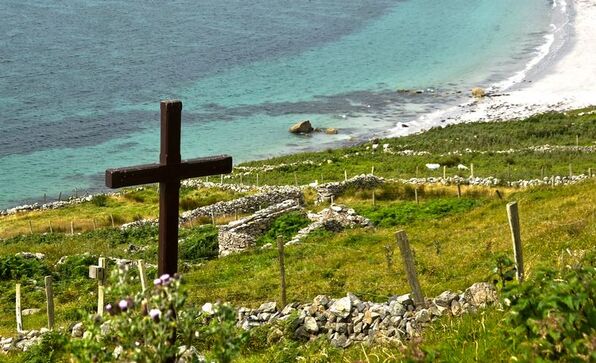 Mass Rock on Arranmore Island, Donegal
Mass Rock on Arranmore Island, Donegal
Dotted around the county, in places hidden from general view, there are old Mass Rocks. Mass Rocks are around 400 years old and are places where Catholics gathered to practice their faith during Penal Times (under Penal Laws brought in and enforced in Ireland from 1695 by the British) when such activity was banned in Ireland. Indeed, if they were caught celebrating Mass, the priest there would more than likely have been killed.
As they were illegal and because of the danger, they had to be hidden and so you will find them in out of the way places which have some high ground from which some of the congregation could keep a look-out in case of danger approaching. To further guarantee secrecy, the masses would not have taken place at set times but rather a time decided and the information passed amongst the people of the area.
The last Mass Rock in Ireland was in Donegal, the Ardaghey Mass Rock which was used right up until 1895.
Some of the Mass Rocks are still in use today. Not of course for regular masses but for special occasion or commemorative masses or maybe just an annual mass.
If you wish to visit any of these places listed below, ask directions in the town or village indicated below and you will get directions ~ it is a lot easier than us trying to describe here how to find them as many are in out of the way places.
Here we have gathered photographs of some of those we have come across on our travels around Donegal. More will be added as they become available.
As they were illegal and because of the danger, they had to be hidden and so you will find them in out of the way places which have some high ground from which some of the congregation could keep a look-out in case of danger approaching. To further guarantee secrecy, the masses would not have taken place at set times but rather a time decided and the information passed amongst the people of the area.
The last Mass Rock in Ireland was in Donegal, the Ardaghey Mass Rock which was used right up until 1895.
Some of the Mass Rocks are still in use today. Not of course for regular masses but for special occasion or commemorative masses or maybe just an annual mass.
If you wish to visit any of these places listed below, ask directions in the town or village indicated below and you will get directions ~ it is a lot easier than us trying to describe here how to find them as many are in out of the way places.
Here we have gathered photographs of some of those we have come across on our travels around Donegal. More will be added as they become available.
CATSBY CAVE MASS ROCK, BALLYSHANNON
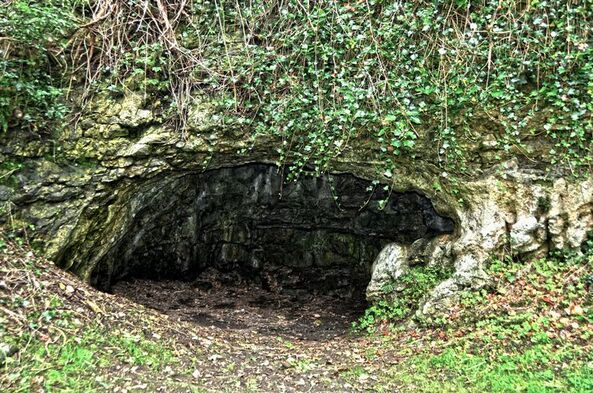 Catsby Cave Mass Rock
Catsby Cave Mass Rock
Just outside the town of Ballyshannon there is the sacred site of Abbey Asseroe with it's Holy Well, the Abbey Well, ancient graveyard, the remains of Assaroe Cistercian monastery and Catsby Cave Mass Rock. A short walk along the (very noisy) river takes you to a clearing where you will find Catsby Cave on your left and a smaller cave to you right.
From the information board: "Any description of Abbey Asseroe would be incomplete without some notice of the curious cave on the bank of the stream, which is known locally as “Catsby” but which we have referred to as “St. Patrick’s Oratory”. It is, unquestionably, of great age. A ledge or seat runs round it; and on the eastern side is a sort of altar, containing two cullauns, or hollows, perhaps for Baptism: the larger one for water, and the smaller, about the size of a hand, for salt."
From BuildingsOfIreland.ie: "This former altar/mass rock represents an interesting historical feature in the landscape to the north-west of Ballyshannon. Mass was celebrated at sites such as this during Penal times (c. 1695 to c 1750) as Catholics were forced to hold secret services in isolated and secluded locations as ‘non conformists’ were not permitted to practice their religions (it was an offence punishable by death for a priest to practice Catholic mass). Although located relatively close to the town of Ballyshannon, ‘Catsby Cave’ is well-hidden and protected on three sides by sheer rock walls, and would have been a perfect site for secret services. It is likely that the priest stood in the small natural cave with his congregation arranged around the hollow outside. This site was probably associated with the now ruinous former Asseroe Cistercian Abbey, the site of which is located immediately adjacent to the north/north-west. The natural cave also has a bullaun stone with two carved basins, which suggests that this site was used for religious service since at least early medieval times, and possibly a lot longer considerably longer. Located in a highly attractive riverside location and surrounded by nature trees, this site is an interesting addition to the social history of the local area."
From the information board: "Any description of Abbey Asseroe would be incomplete without some notice of the curious cave on the bank of the stream, which is known locally as “Catsby” but which we have referred to as “St. Patrick’s Oratory”. It is, unquestionably, of great age. A ledge or seat runs round it; and on the eastern side is a sort of altar, containing two cullauns, or hollows, perhaps for Baptism: the larger one for water, and the smaller, about the size of a hand, for salt."
From BuildingsOfIreland.ie: "This former altar/mass rock represents an interesting historical feature in the landscape to the north-west of Ballyshannon. Mass was celebrated at sites such as this during Penal times (c. 1695 to c 1750) as Catholics were forced to hold secret services in isolated and secluded locations as ‘non conformists’ were not permitted to practice their religions (it was an offence punishable by death for a priest to practice Catholic mass). Although located relatively close to the town of Ballyshannon, ‘Catsby Cave’ is well-hidden and protected on three sides by sheer rock walls, and would have been a perfect site for secret services. It is likely that the priest stood in the small natural cave with his congregation arranged around the hollow outside. This site was probably associated with the now ruinous former Asseroe Cistercian Abbey, the site of which is located immediately adjacent to the north/north-west. The natural cave also has a bullaun stone with two carved basins, which suggests that this site was used for religious service since at least early medieval times, and possibly a lot longer considerably longer. Located in a highly attractive riverside location and surrounded by nature trees, this site is an interesting addition to the social history of the local area."

